The Complete Guide to AI Integration for San Antonio Businesses

Working together on AI for San Antonio Businesses – a local owner and helper review tasks and growth numbers.
AI Integration for San Antonio Businesses enhances what already works without major disruption. Learn the COMPASS FrameworkSM, avoid costly mistakes, and join local businesses seeing results in 90 days.
It’s Wednesday. Hot. You’re at work.
Bad news hits. Your biggest rival got AI. They work twice as fast now.
Your phone rings. Workers have questions. Customers ask why you’re slow. You feel sick.
Sound like you?
Most San Antonio business owners built good things. You drive trucks. Fix air. Feed people.
You made it through bad times. You changed when needed. People trust you.
But AI changes everything fast. Customers want more.
AI isn’t just talk now. It changes what customers want. Will you use it right? Or rush while rivals steal customers?
Here’s what you’ll learn. Businesses like yours win with AI. They don’t replace good things. They make them better.
AI Truth for San Antonio
Meet Maria. She owns an AC business. Her grandpa started it in 1967. Her dad grew it. She made it through hard times.
But she’s scared. She might pick wrong AI. Waste six months. Rivals might get ahead.
This fear is everywhere in San Antonio. Research shows AI awareness is high. But few businesses use it.
Texas leads in AI use. The Dallas Fed says Texas business AI use jumped from 5.4% in 2018 to 59.1% by May 2025.
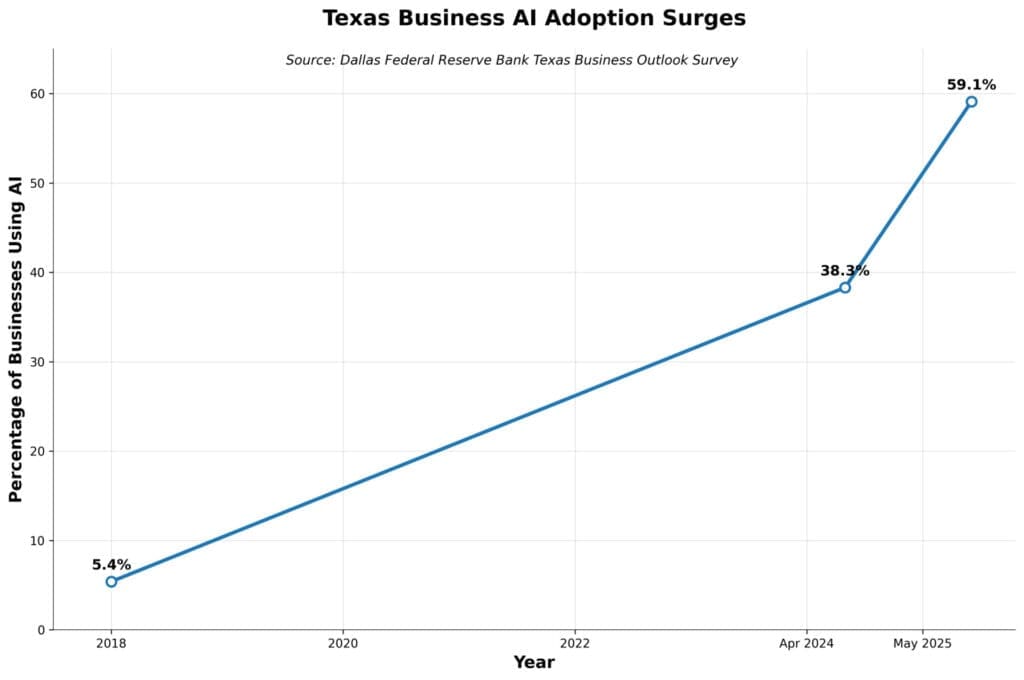
AI adoption among Texas businesses has grown over 10x in seven years, reaching 59.1% in 2025 according to the Dallas Fed.
Why do most businesses wait?
Setup and Smart Use Are Different
Setup means buying software. Training people. Smart use means making AI work with what you do. It makes everything better.
Think about this. You can buy the best customer system. That’s setup. But if you don’t use it right, it’s expensive junk.
A truck company served San Antonio for 15 years. The owner could spend $50,000 on fancy AI. But what if it doesn’t fit? Then it’s another tool that sits there.
San Antonio Has Special Benefits
Our market is different. We mix old business ways with new tech. Customers want personal service made better with smart tools.
In Silicon Valley, everyone expects new tech. In San Antonio, businesses can get huge benefits from basic AI. Why? Most rivals don’t use it yet.
A plumber in Northwest San Antonio doesn’t need complex AI. They need help with emergency calls. Better customer talk. Keep personal touch while being fast.
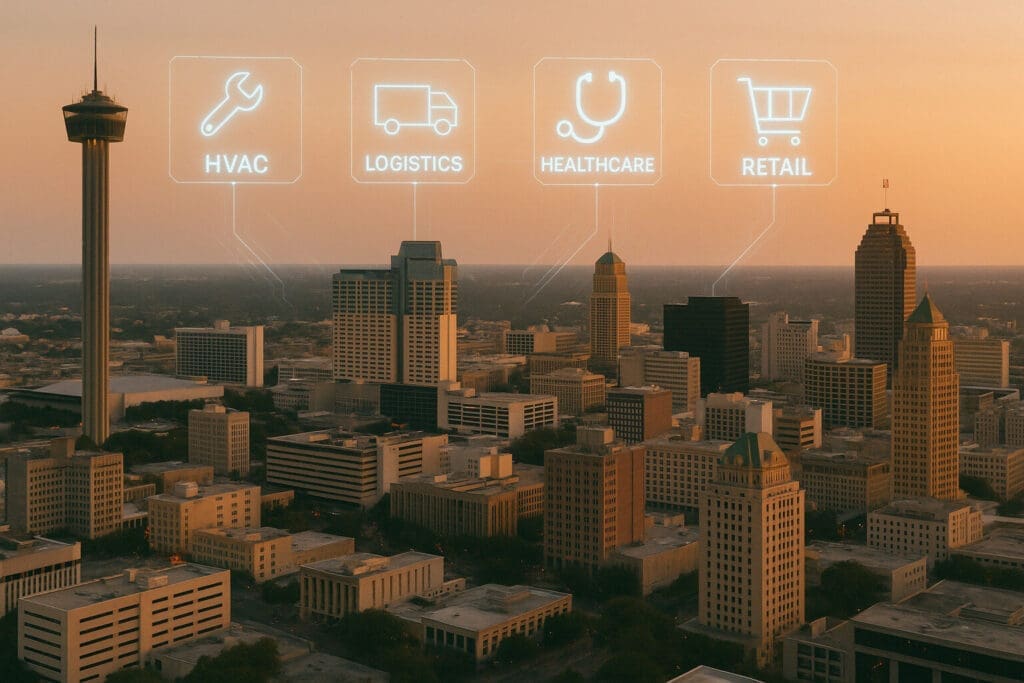
AI for San Antonio Businesses shown across areas like HVAC, shipping, healthcare, and retail.
Small Businesses Don’t Need Big Systems
Small businesses don’t need huge AI. They need simple fixes. These solve problems. Build a base for growth.
The best AI starts with one fix. Shows clear value fast. Then grows.
A food supply business serves South Texas. They don’t need to change everything. Start with alerts. Stop running out of popular items. Add tools to predict busy times. Later, add customer chat.
What’s the difference between AI tools and smart AI use?
AI tools are software with smart features. Smart AI use makes these tools work with your business. Creates real fixes. Makes work flow better.
💡 Calculate Your Potential AI Savings
Wondering what AI could save your San Antonio business? Use this calculator to estimate your potential time and cost savings:
Example: If AI saves you 20 hours/week at $50/hour, that’s $52,000 annually in time savings alone.
Local businesses using AI smart can meet higher hopes. Rivals with old ways struggle.
Research shows small businesses using AI see 32% growth in year one. 89% get good returns in 18 months.
These aren’t just numbers. They show real change can happen. The key is clear AI planning. Not random picking.
Why AI Works for San Antonio Businesses
You own a plumber business. Northwest San Antonio area. At 11:23 PM, you get a text:
“The AI we set up handled that emergency call. I was sleeping. Customer got help fast. We sent the right guy. Customer was happy. Told two neighbors.”
Six months ago, you worked 70 hours each week. Handled every call. Did all scheduling. Dealt with every emergency.
Your business was good. But hard to keep up. Every vacation got cut. Every dinner might get ruined.
Smart AI changes this. Works with San Antonio business culture.
Making Bonds Stronger
San Antonio businesses win on bonds. Community ties. AI makes these stronger. Doesn’t replace them.
Good AI doesn’t replace personal service. Helps you give better service more often.
Customer calls with emergency. AI works fast. Finds their history. Checks available techs. Guesses arrival times. Sends updates.
This frees you for complex problems. Building bonds. AI handles routine stuff.
Result? Customers get faster, better service. Feel more connected. Not less.
Our City Creates AI Chances
San Antonio spreads out huge. Downtown to Stone Oak to Alamo Ranch. This creates problems AI solves well.
Local businesses using AI for routes get big benefits. Beat rivals who plan by hand.
Think about tax business. Clients from Helotes to Schertz. AI makes scheduling better by location. Adjusts for traffic. Gives clients accurate arrival times.
This turns shipping nightmare into edge.
Our Economy Supports AI Investment
San Antonio has many different businesses. Gives stability. Lets you invest in tech.
Our economy has strong areas:
- Military
- Healthcare
- Tourism
- Making things
- Tech
This mix creates steady demand for services. Gives stability for AI investments.
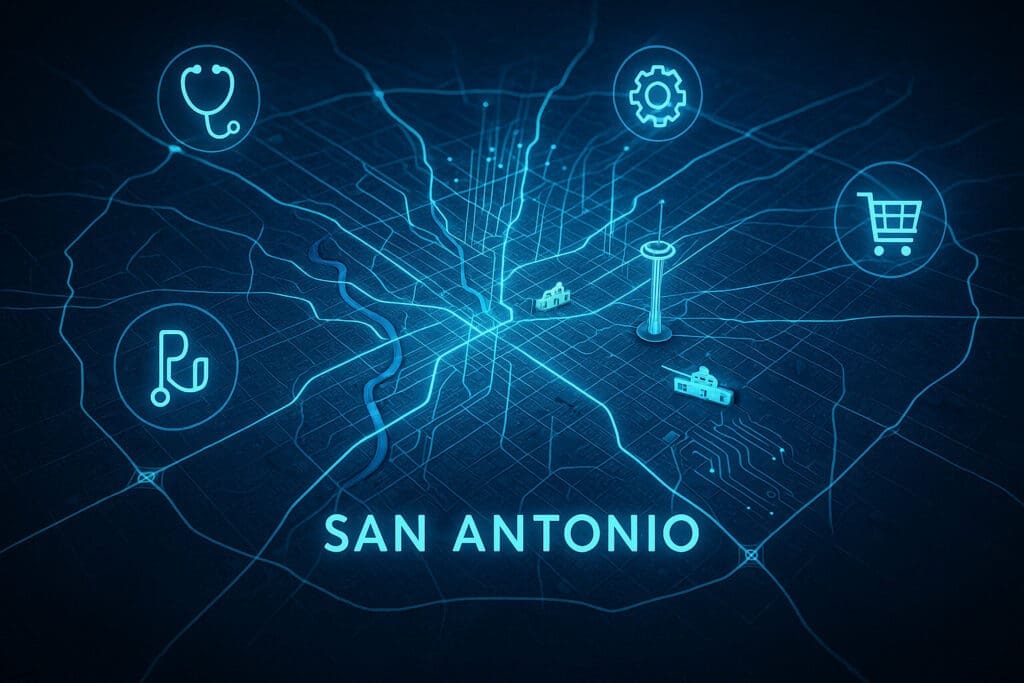
San Antonio is lighting up with AI. AI for San Antonio Businesses is changing healthcare, shipping, retail, and making things—one workflow at a time.
Our Culture Likes Smart Tech
San Antonio culture likes tech that solves real problems. Doesn’t throw away old values. Perfect for AI that helps rather than replaces human thinking.
Best AI projects respect old business ways. Bring speed. Let owners spend more time on customer bonds. Smart planning.
Brian’s 25-Year Insight
San Antonio businesses win with AI when they think “tech helps us be more of who we are” not “tech changes who we become.” This cuts pushback. Speeds adoption. Gets better results.
How do San Antonio customers respond to AI in local businesses?
When done right, customers respond very well. AI makes service quality better. Keeps personal bonds strong. Key is making sure AI helps rather than replaces human talk.
The COMPASS FrameworkSM
You own a food supply business. Served San Antonio cafes for 20 years.
Orders get lost. Count numbers are wrong. Staff spend more time on paperwork than helping customers.
“We’re drowning in hand work,” you think. Another late night fixing count problems.
This led to COMPASS FrameworkSM. Simple way. Guided good AI projects for San Antonio businesses. Shows exactly how to add AI without breaking what works.
COMPASS stands for:
- Capture – Document how your business works to see every step clearly
- Observe – Spot time drains and hidden leaks in your workflow
- Map – Chart the clearest route to faster, smarter systems
- Prioritize – Focus on changes that drive the biggest gains
- Analyze – Make data-backed decisions, every step of the way
- Streamline – Simplify. Automate. Remove the drag on your team
- Sustain – Keep AI working and evolving with the business
Each step builds on the last. Creates complete plan. Gets results. Respects existing business culture.
C – Capture: Document Your Current Workflows
First step documents how your business really works. Not how you think it works. Not what the manual says. What actually happens.
For the food supply business, capture means mapping every step from initial customer order to final delivery. Include phone calls, emails, inventory checks, and even informal communication between staff.
Most business owners discover their actual processes differ significantly from what they assumed. This documentation reveals both strengths to preserve and inefficiencies to address.
How to Capture Effectively:
- Shadow staff through complete work cycles
- Document every step, including informal processes
- Time each activity to understand true resource allocation
- Note where information gets lost or duplicated
- Record decision points and who makes them
O – Observe: Identify Time Drains and Workflow Leaks
Once you’ve captured your workflows, observe where time and resources disappear. Look for patterns in delays, errors, and inefficiencies.
For food supply business, observation might reveal that staff spend 40% of their time on phone calls because the ordering system doesn’t integrate with inventory. Or that three different people handle the same customer information.
Observation goes beyond obvious problems. Find subtle inefficiencies that compound over time.
What to Observe:
- Tasks that require multiple people or systems
- Information that gets entered more than once
- Processes that stop while waiting for responses
- Errors that create additional work
- Decision bottlenecks that slow everything down
M – Map: Chart Your Route to Optimization
Map creates your optimization roadmap. Shows which improvements deliver maximum impact with minimum disruption.
Rather than trying to fix everything at once, mapping prioritizes changes that build on each other. Start with foundations that enable more advanced improvements later.
For the food supply business, mapping might show that automating inventory alerts enables better ordering, which enables predictive stocking, which enables customer service improvements.
Mapping Strategy:
- Identify high-impact, low-risk starting points
- Design improvement sequences that build on each other
- Plan for minimal business disruption
- Account for staff learning curves
- Create fallback options for each improvement
P – Prioritize: Focus on Changes That Drive Results
Prioritization ensures you focus resources on improvements that deliver measurable business value. Not just cool technology features.
Use impact-versus-effort analysis to rank potential improvements. High-impact, low-effort changes become your starting priorities.
For food supply business, automated low-stock alerts might rank higher than complex demand forecasting because alerts deliver immediate value with simple implementation.
Prioritization Framework:
- Rank improvements by business impact potential
- Assess implementation complexity and risk
- Consider staff adoption requirements
- Evaluate technology integration needs
- Account for measurable result timelines
A – Analyze: Make Data-Backed Decisions
Analysis uses real data to guide implementation decisions and measure progress. Eliminates guesswork from your AI integration strategy.
Establish baseline measurements before implementing changes. Track both operational metrics and business outcomes throughout the process.
For food supply business, analysis tracks order processing time, inventory accuracy, customer satisfaction scores, and revenue per customer alongside operational efficiency measurements.
Analysis Approach:
- Establish baseline measurements before changes
- Track leading indicators that predict success
- Monitor both efficiency gains and business outcomes
- Use data to refine and optimize implementations
- Make course corrections based on actual performance
S – Streamline: Simplify and Automate Operations
Streamlining eliminates unnecessary complexity while automating repetitive tasks. Focus on making work easier for your team while improving customer experience.
The goal isn’t maximum automation. It’s optimal automation that enhances rather than replaces human judgment and relationship building.
For food supply business, streamlining might automate routine reorders while preserving human involvement in customer relationship management and problem-solving.
Streamlining Principles:
- Automate repetitive, rule-based tasks
- Eliminate unnecessary steps and redundancies
- Simplify decision-making processes
- Preserve human involvement in relationship building
- Create systems that grow with your business
S – Sustain: Keep AI Working and Evolving
Sustainability ensures your AI implementations continue delivering value as your business changes and grows. This isn’t a one-time project but an ongoing capability development process.
Plan for system maintenance, staff training updates, and capability expansion. Your AI should adapt to new business requirements rather than becoming obsolete.
For food supply business, sustainability might involve quarterly system reviews, ongoing staff training, and planned capability additions based on business growth.
Sustainability Elements:
- Regular performance monitoring and optimization
- Ongoing staff training and capability development
- System updates and technology evolution planning
- Capability expansion based on business growth
- Long-term strategic planning integration
Following the COMPASS FrameworkSM typically produces big improvements:
- Operational efficiency increases 60-70%
- Error rates drop 85-95%
- Customer satisfaction improves significantly
More importantly, these improvements free owners and staff. Focus on customer bonds and business development.
5 Big AI Mistakes San Antonio Businesses Make
You just spent $40,000 on AI for your tax practice. Salesperson said it would change everything. Document processing. Client talk. Money analysis.
Six months later, system sits unused. Nobody knows how to make it work with your processes. Partners question your judgment. You think you made huge mistake.
This shows most expensive AI mistake I see. Choosing fancy tech before understanding what you need.
After years helping San Antonio businesses with AI, I found five big mistakes. Account for 89% of failed AI projects.
Mistake #1: Picking Tech First
Problem: Choosing AI solutions based on cool features rather than specific business needs.
Tax firm chooses enterprise AI platform. Choose it because offers amazing abilities. Document processing. Client talk. Money analysis.
But system needs lots of customization to work with existing software. Complexity overwhelms staff comfortable with established work flows.
Cost: Beyond initial investment, businesses typically lose 6-8 months productive time during failed setup attempts. Plus additional helper fees trying to make systems work together.
Solution: Start with business outcome needs. Then evaluate AI solutions based on how easily they integrate. How well staff can adopt them.
Most effective AI projects often use simpler tech that works smoothly.
How to Prevent:
- Define specific business problems before looking at tech solutions
- Evaluate AI tools based on how well they fit current setup
- Put solutions first that work with existing systems
- Test compatibility through pilot projects
- Think about total cost including training and support
For guidance on choosing right approach, read our post on Using AI and Marketing for Small Business Success.
Mistake #2: Not Preparing Staff Right
Problem: Installing AI systems without proper staff training. Talk. Change management processes.
Think about medical equipment sales company. Setting up AI for customer relationship management. Setup fails because staff get minimal training. Feel threatened by tech they don’t understand.
“We spent weeks learning new system,” senior sales helper might say. “But nobody explained how it would make our jobs better. Felt like management trying to replace us with computers.”
Cost: Extended setup timelines (8 months instead of 3). Productivity declining 30-40% during transition. Potential loss of experienced staff who feel displaced.
Solution: Invest significant time and resources in change management. Staff training. Clear talk about AI benefits for employees and customers.

AI for San Antonio Businesses isn’t just tech—it’s teamwork. This session shows business owner guiding employees through real-time prompts, analytics, and automation strategies that make AI work across departments.
Change Management Best Practices:
- Include staff in AI solution evaluation
- Give complete training that builds confidence
- Talk clearly about how AI enhances job security
- Set up feedback mechanisms for ongoing worries
- Recognize and reward successful AI adoption
Mistake #3: Expecting Results Too Fast
Problem: Expecting immediate results from AI. Not allowing adequate time for system optimization and staff adaptation.
Vet practice implements AI for appointment scheduling and client talk. Setup is technically successful. But initially creates more work than eliminates.
This happens because expectations weren’t properly managed.
“I thought AI system would immediately reduce our phone calls and admin work,” practice owner might reflect. “When it actually increased our workload during first six weeks, I almost cancelled whole project.”
Cost: Nearly abandoning potentially valuable AI. Could deliver exceptional results after proper optimization and staff adaptation.
Solution: Set realistic timelines. Account for setup phases. Staff learning curves. System optimization periods.
Realistic Timeline Framework:
- Weeks 1-4: Foundation setup with initial staff training
- Weeks 5-8: System optimization based on initial usage patterns
- Weeks 9-16: Full setup with ongoing refinement
- Weeks 17-24: Advanced feature rollout
- Ongoing: Continuous optimization
How long should San Antonio businesses expect AI to take before seeing real results?
Most businesses see initial improvements within 4-6 weeks. Big benefits by 12-16 weeks. Full optimization within 6-9 months. Key is starting with manageable expectations. Building success step by step.
Mistake #4: Poor Data Prep
Problem: Attempting AI without properly organizing, cleaning, and preparing existing business data.
Think about construction company. Specializes in commercial projects throughout San Antonio. Their AI for project management and cost estimation fails.
This happens because 20 years of project data scattered across multiple systems. Has inconsistent formatting and significant gaps.
“AI system couldn’t give accurate estimates because our historical data was too messy,” owner realizes. “We had to spend four months organizing information before AI could actually help us.”
Cost: Additional data organization expenses. Delayed benefits by 4-6 months.
Solution: Conduct thorough data audit and preparation before implementing AI systems. These depend on historical information for optimal performance.
Mistake #5: Treating It Like One-Time Project
Problem: Treating AI setup as one-time project. Not as ongoing optimization and strategic development process.
Marketing agency successfully implements AI for content creation and social media management. However, treat setup as complete once system is operational. Miss opportunities for optimization and strategic expansion.
“We were satisfied with our initial results,” owner might reflect months later. “We stopped thinking about how to improve system. I realized we were only using about 30% of AI’s potential to help our clients.”
Cost: Opportunity cost of missed efficiency improvements. Missed competitive advantages. Missed client service enhancements worth significant annual revenue potential.
Solution: Set up ongoing optimization processes and strategic planning. Treat AI as continuous improvement opportunity rather than completed project.
Brian’s 25-Year Insight
Most successful AI projects I’ve helped treat tech setup as beginning of strategic capability development process. Not end goal. Businesses that continuously optimize their AI systems see 3-4 times greater long-term benefits.
How to Know If AI Works
“How will I know if this actually works for my business?”
Every smart business owner thinking about AI asks this question. Deserves complete answer backed by measurable results.
You own three physical therapy clinics across San Antonio. Serve everyone from weekend warriors with sports injuries to elderly patients recovering from surgery.
Your practice is profitable and well-regarded. But hand scheduling eats up time. Insurance processing takes forever. Patient talk needs constant attention.
“I need to see real numbers that prove AI is worth investment,” you tell yourself. “I’m not interested in just feeling like tech is helping. I need to measure actual improvement in ways that matter to my business.”
This focus on measurable results leads to Strategic Value Measurement System. Complete approach to tracking AI return on investment. Goes beyond basic efficiency numbers. Captures actual business value creation.
Foundation Numbers: Daily Improvements
Foundation numbers track immediate work improvements AI delivers. These measurements give early validation of success. Find areas needing optimization.
Time-Based Efficiency Numbers:
Appointment scheduling might average 4.3 minutes per appointment before AI. Includes phone calls. Calendar coordination. Confirmation processes.
After AI, this could decrease to 1.7 minutes per appointment. 60% reduction that frees staff time for patient care and relationship building.
Error Reduction Measurements:
Hand insurance claim processing might have 12% error rate. Needs resubmission and follow-up. AI-assisted claim processing could reduce this to 2.8%.
This eliminates about 15 hours per week of correction work. Improves cash flow through faster payment processing.
Resource Use Optimization:
AI helps optimize schedules and resource use. Practice might average 73% schedule efficiency with 18% no-show rates before AI.
After AI for appointment reminders and schedule optimization, efficiency could increase to 89%. No-show rates drop to 7%.
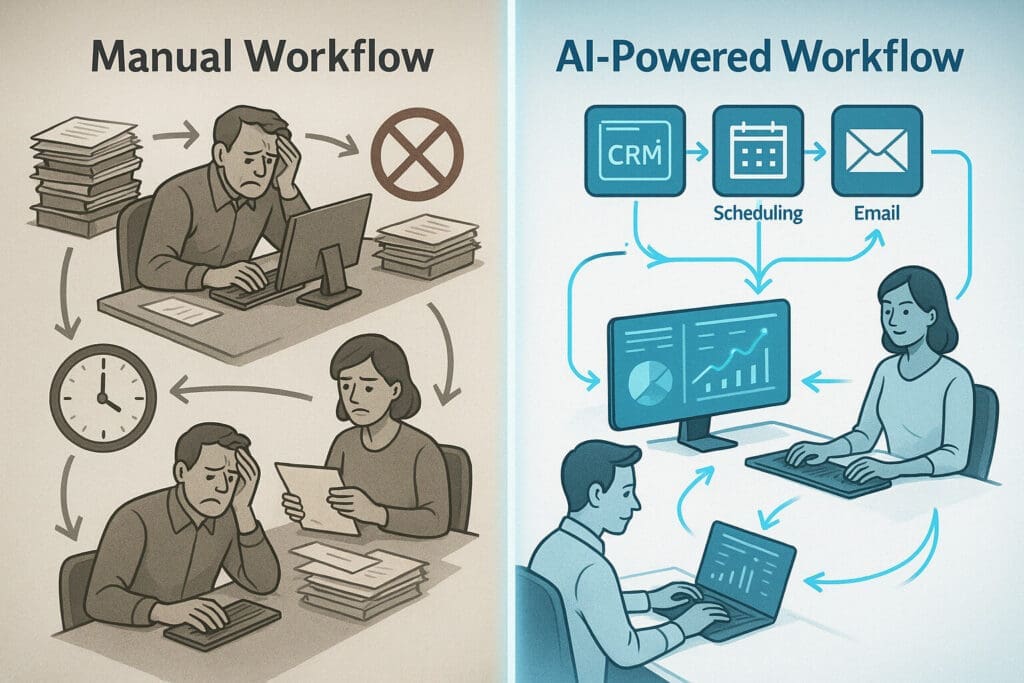
AI for San Antonio Businesses turns frustration into focus—this side-by-side shows clear shift from hand chaos to streamlined, automated clarity.
Revenue Impact Numbers: Direct Money Benefits
Revenue impact measurements track how AI affects business income. Through improved service delivery. Customer satisfaction. Work capacity.
Capacity Expansion Without Adding Staff:
Most significant revenue impact often comes from increased capacity. Don’t hire additional admin staff.
AI might enable serving 34% more patients with same admin team. Generates substantial additional annual revenue.
Customer Lifetime Value Improvements:
AI-enhanced talk and follow-up could increase patient retention rates from 67% to 84%.
For healthcare practices, this improvement translates to significant additional annual revenue. Comes from existing patients completing full treatment programs. Return for future care.
For more insights on customer service improvements, read our guide on Making Customer Service Better with AI.
Cost Reduction Numbers: Expense Improvements
Cost reduction measurements capture how AI reduces work expenses. Through improved efficiency. Error reduction. Resource optimization.
Admin Cost Reductions:
AI typically reduces admin labor costs significantly through:
- Automated appointment scheduling
- Insurance verification
- Customer talk
These tasks previously needed hand staff time.
Error-Related Cost Elimination:
Insurance claim errors and resubmissions represent substantial annual costs. Staff time and delayed payments. AI-assisted claim processing can eliminate 80-90% of these costs.
What’s a realistic ROI timeline for AI in San Antonio small businesses?
Most businesses see positive ROI within 6-9 months. Full benefits realized within 12-18 months. Initial efficiency gains appear within 30-60 days. But complete ROI needs time for staff adaptation and system optimization.
ROI Calculation Framework for San Antonio Businesses
Based on typical projects across San Antonio businesses, here’s practical ROI calculation framework:
Year One ROI Parts:
- Direct revenue increases through capacity expansion
- Cost reductions from admin, error, and system efficiencies
- Setup investment including tech, training, and consulting
- Typical Net Year One Benefit: 300-600% ROI
Ongoing Annual Benefits (Years 2-5):
- Sustained revenue improvements
- Continued cost reductions
- Minimal ongoing tech costs
- Typical Net Annual Benefit: Continued strong positive ROI
This ROI framework shows why AI represents strategic investment rather than work expense for established San Antonio businesses.
Brian’s 25-Year Insight
Businesses that achieve highest ROI from AI focus on measuring business outcomes rather than tech numbers. Track improvements in customer happiness. Revenue per customer. Work efficiency. Competitive positioning. Not just system uptime and feature usage.
Real AI Success Stories from San Antonio
Most powerful proof of AI potential comes from understanding how businesses similar to yours have achieved remarkable transformations. While every business is unique, patterns of success reveal principles that apply across industries and business models.
These transformations represent real possibilities for established San Antonio businesses. Willing to approach AI strategically rather than reactively.
Success Story #1: Auto Service Revolution
Think about family-owned auto group. Been serving San Antonio for nearly 40 years. Run service departments across three locations.
Business built reputation on reliable service and fair pricing. But hand scheduling and talk processes created bottlenecks. Limited capacity and frustrated customers.
Challenge: Service departments processing 240 vehicles per week across three locations. But inefficiencies meant service advisors spent 60% of their time on admin tasks. Left insufficient time for customer consultation and relationship building.
AI Approach: Setup focused on three core areas:
- Smart scheduling that optimized technician assignments and reduced customer wait times
- Automated customer talk giving real-time updates on repair progress
- Predictive maintenance alerts helping customers prevent expensive repairs
Results After 12 Months:
- Service capacity increased 40-50% without additional technician hiring
- Customer happiness scores improved from 3.8 to 4.6+
- Service advisor productivity increased 60-70%
- Average repair ticket value increased 25-30%
- Customer retention rates improved from 64% to 80%+
Revenue Impact: Service departments generated $700,000-$900,000 in additional annual revenue through increased capacity and improved customer retention.
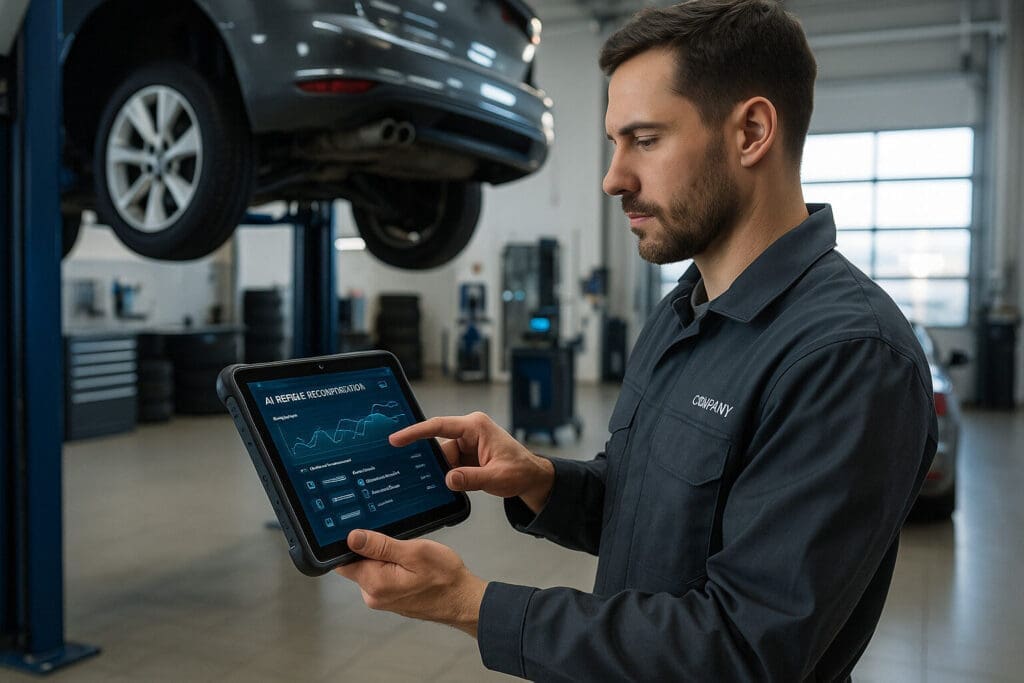
AI for San Antonio Businesses is already driving results in automotive world. This technician uses real-time repair suggestions generated by AI to streamline diagnostics and speed up service.
“Transformation goes beyond work efficiency,” this type of owner might reflect. “AI helps us become kind of service provider we always wanted to be. Technically excellent and genuinely customer-focused.”
For more examples of local success stories, see our post on How San Antonio Businesses Are Using AI.
Success Story #2: Healthcare Practice Optimization
Think about medical practice managing multiple locations. Serving diverse patient populations from routine care to specialized treatments.
Hand appointment scheduling consumed excessive time. Insurance verification created delays. Patient talk relied on hand processes that often led to miscommunication and missed appointments.
Challenge: Admin tasks consumed 70% of front office staff time. Appointment scheduling required multiple phone calls to coordinate. Patient talk relied on hand processes prone to errors.
AI Strategy: Systematic setup addressing:
- Smart appointment scheduling considering physician availability, patient preferences, and treatment requirements
- Automated insurance verification and pre-authorization management
- Personalized patient talk for appointment reminders, follow-up care, and health education
Results After 15 Months:
- Admin efficiency improved 65-75%
- Appointment scheduling time reduced from 8 minutes to 2 minutes per appointment
- No-show rates decreased from 15% to 6%
- Patient happiness scores increased from 4.1 to 4.7
- Provider productivity increased 30-40%
Financial Impact: Practice could serve 25-35% more patients with existing staff while improving care quality and patient satisfaction.
Advanced AI Strategies for Long-Term Success
Initial success of AI creates foundation for advanced optimization strategies. These compound benefits over time.
Most businesses stop at basic setup. Miss opportunities for strategic advantages. These separate market leaders from followers.
Think about where your business could be two years from now. AI could evolve from work tool to strategic capability.
Businesses that achieve sustained competitive advantage treat AI as ongoing capability development process. Not completed tech project.
Data-Driven Strategic Planning
Once AI systems accumulate sufficient work data, they enable strategic planning capabilities. These weren’t previously possible for small businesses.
Instead of making decisions based on intuition and limited historical perspective, you can leverage comprehensive analytics for competitive advantage.
Predictive Analytics for Business Planning:
Think about food supply business. Accumulated 18 months of AI-enhanced work data.
System now identifies seasonal demand patterns. Predicts customer ordering behaviors. Recommends inventory optimization strategies. Reduce carrying costs while eliminating stockouts.
This data enables strategic decisions about:
- Seasonal staffing adjustments based on predicted demand patterns
- Product line expansion opportunities
- Geographic expansion strategies
- Pricing optimization based on customer sensitivity analysis

AI for San Antonio Businesses means smarter forecasting, tighter strategy, and faster decisions. This executive dashboard brings everything into focus—from revenue projections to real-time engagement numbers.
Performance Optimization and Continuous Improvement
Advanced optimization needs systematic approaches to performance monitoring. System refinement. Capability expansion.
Automated Performance Monitoring:
Mature AI systems include automated performance monitoring. Identifies optimization opportunities. System inefficiencies. Emerging requirements.
This automated monitoring enables proactive system improvement rather than reactive problem-solving.
For insights on ongoing optimization, read our guide on Smart AI Workflow Automation for Small Business Success.
Brian’s 25-Year Insight
Businesses that achieve greatest long-term value from AI treat it as strategic capability development process. Not tech setup project. They continuously evolve their AI systems to support changing business requirements and emerging market opportunities. This creates competitive advantages that become increasingly difficult for competitors to overcome.
Your Next Steps to AI Success
Standing at threshold of AI can feel overwhelming. But successful setup follows proven pathway. Cuts risk while maximizing results.
Your next steps depend on where your business stands today. How quickly you want to realize competitive advantages.
Window of opportunity for first-mover advantage in San Antonio’s market remains open. But it’s narrowing as more businesses recognize AI as essential rather than optional.
Businesses that begin strategic setup now will establish positions. These become increasingly difficult for competitors to challenge.
Immediate Action Steps (Next 30 Days)
Step 1: Business Assessment and Goal Definition
Begin with honest assessment of current work challenges and growth objectives. Use Clarity from the COMPASS FrameworkSM to identify three specific business outcomes AI should deliver.
Document current processes that consume excessive time. Create customer friction. Limit business growth.
Quantify these challenges with specific time measurements. Error rates. Cost implications.
Step 2: Initial AI Readiness Evaluation
Assess your business’s readiness for AI by evaluating:
- Current tech infrastructure and AI integration compatibility
- Staff tech comfort levels and training requirements
- Data organization and quality levels
- Financial capacity for setup and optimization phases
- Timeline flexibility for gradual setup approach
Take the AI Readiness Assessment to receive personalized evaluation of your business’s potential and recommended starting points.
Step 3: Market Research and Competitive Analysis
Research how competitors in your industry and market are approaching AI. Find gaps in competitor capabilities that create opportunities for competitive advantage through strategic AI setup.
Understanding competitor activities helps put in order AI areas. These give maximum differentiation and market positioning benefits.
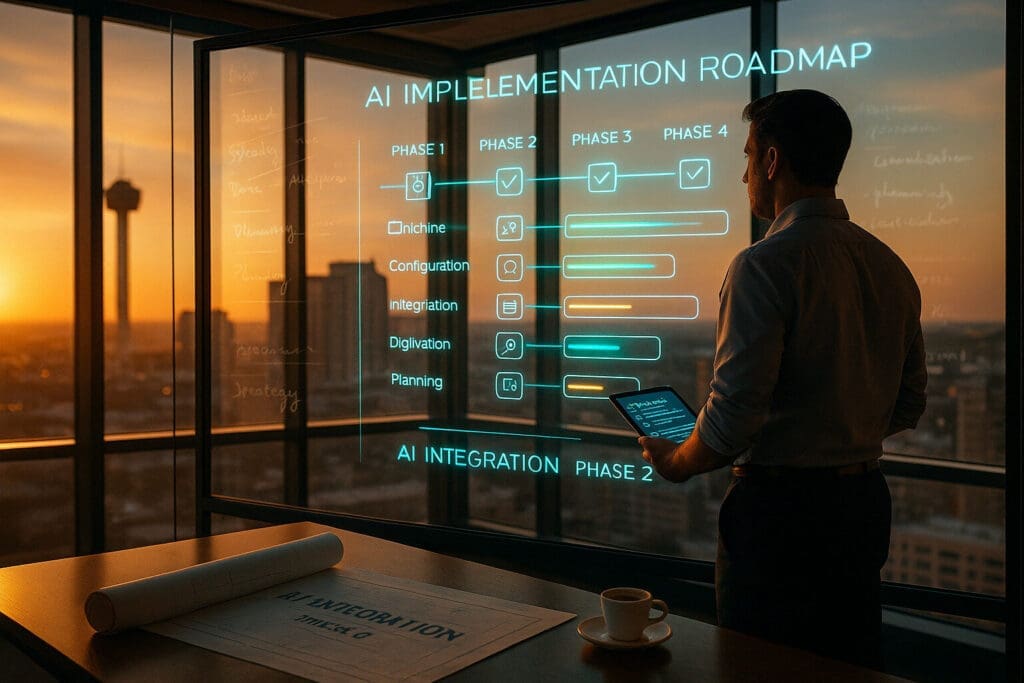
Before city wakes up, decisions are already being made. This business owner reviews AI setup roadmap—proof that AI for San Antonio Businesses starts with vision, not just software.
Setup Phase Planning (Months 2-6)
Month 2: Solution Evaluation and Vendor Selection
Based on your business assessment, evaluate AI solutions that align with your actual needs rather than impressive feature lists.
Put solutions first that integrate with existing systems. Match staff tech capabilities.
Request demonstrations that focus on your specific use cases rather than general capabilities. Evaluate vendors based on setup support. Training resources. Ongoing optimization assistance.
Month 3: Foundation Setup
Begin with single-process AI that shows immediate measurable benefits. This foundation setup builds confidence. Gives learning experience for expanded setup.
Focus on processes that are:
- High-impact for customer experience or work efficiency
- Low-risk for business disruption
- Clearly measurable for success validation
- Expandable for future phases
For practical setup guidance, read our AI Automation Tasks San Antonio Businesses Can Do Today.
Months 4-6: Expansion and Optimization
Based on foundation setup success, expand AI to additional processes. Optimize initial projects based on usage patterns and feedback.
This expansion phase should maintain focus on business outcomes rather than tech features. Make sure each addition delivers measurable value before moving to next opportunity.
Resource and Investment Planning
Financial Investment Framework:
Typical AI investment ranges from $15,000-$75,000 for initial setup. Depends on business size and complexity. This investment typically generates 300-600% ROI within first year.
Plan for setup costs including:
- Tech licensing and setup fees
- Staff training and capability development
- Consulting and optimization support
- Ongoing system maintenance and updates
Timeline and Resource Allocation:
Successful AI setup needs dedicated time and attention from business leadership and key staff. Plan for:
- 10-15 hours per week of leadership involvement during setup phases
- 20-30 hours of staff training and adaptation time
- Ongoing optimization and monitoring requirements
For more detailed planning guidance, see our San Antonio Business AI Solutions guide.
What’s the most important first step for San Antonio businesses thinking about AI?
Most important first step is completing honest assessment of current work challenges. Define three specific business outcomes you want AI to deliver. This clarity guides all subsequent decisions. Makes sure setup focuses on business value rather than tech features.
Key Takeaways for San Antonio Business Success
- AI enhances existing strengths rather than replacing them
- Strategic timing creates significant competitive advantages
- The COMPASS FrameworkSM cuts setup risk while maximizing results
- Employee engagement and buy-in drive setup success
- Measurement focus on business outcomes determines ROI success
- Ongoing optimization compounds benefits over time
For additional strategies, explore our guide on revolutionizing small business with AI automation.
Frequently Asked Questions About AI for San Antonio Businesses
How much should San Antonio small businesses budget for AI setup?
Initial AI setup typically needs $15,000-$75,000 investment. Depends on business size and complexity. Most businesses see positive ROI within 6-9 months. Many achieving 300-600% returns in first year.
Will AI disrupt our existing business bonds and culture?
When set up strategically, AI enhances rather than disrupts business bonds. Key is choosing solutions that strengthen your existing advantages. San Antonio businesses succeed by using AI to deliver better personal service more consistently.
How do we prevent AI from overwhelming our staff?
Success comes from gradual setup starting with single-process improvements. Show immediate benefits. Include staff in solution selection. Give complete training. Talk clearly about how AI makes jobs easier rather than threatened.
Can small businesses compete with large corporations that have bigger AI budgets?
Small businesses often have AI advantages. Include faster decision-making. Simpler setup requirements. Stronger customer bonds. Focus on targeted solutions that solve specific problems rather than trying to match enterprise-level systems.
Which small business tasks should be automated first?
Start with repetitive, time-consuming tasks that don’t need complex decision-making. Customer talk, appointment scheduling, inventory alerts, and basic data entry are excellent starting points. According to industry research, these areas typically show fastest ROI.
Your AI journey begins with single decision. Will you approach this strategically or reactively?
Businesses that start with clear objectives achieve best results. Use systematic setup. Focus on business outcomes rather than tech features.
Competitive landscape in San Antonio is shifting. Question isn’t whether AI will impact your business. It’s whether you’ll leverage this transition to strengthen your market position. Or watch competitors capture advantages you could have claimed.
Ready to explore AI for your San Antonio business? Join successful businesses already using AI strategically. Market is growing rapidly. Early adopters are seeing biggest gains.
Start your journey by learning more about how San Antonio businesses are using AI to get their day back. Discover AI workflow strategies for small and medium businesses.
